练习网站
1.网页sql zoo,切换到MySQL

2.点击SELECT from word,开始练习第一题
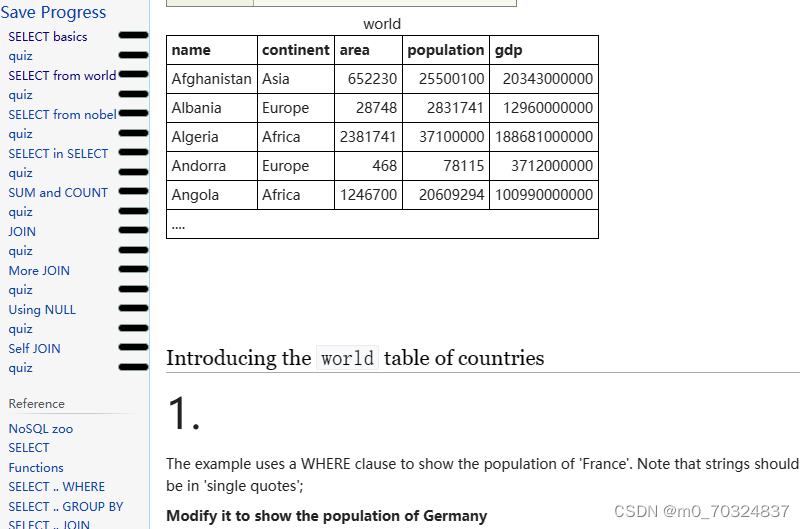
一.基础语句
主知识点一:select&from
第一题:从单表中查询多列
在select后指定要查询的字段名称,多个字段名之间用英文逗号隔,最后一个字号不加逗号

“Select * from word”从表格中查询所有的列

“as”别名,原数据不会被改变,可以用空格代替

第二题:选择所有大洲且每个大洲只出现一次
“select distinct continent from word ”实现去重功能,放在多个字段前,对多个字段去重,不能放在字段后面
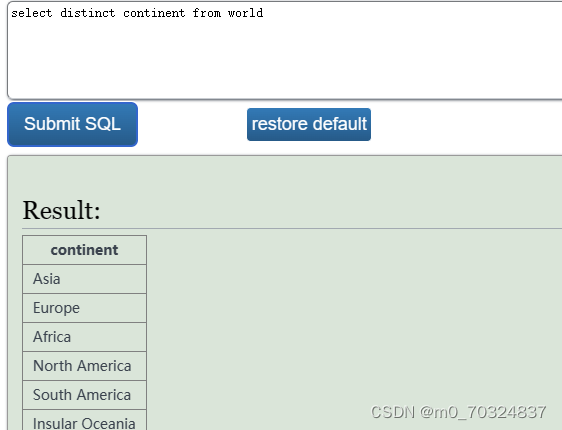
第三题:除法计算人均GDP
Gdp/population,同理,加减乘除均可计算
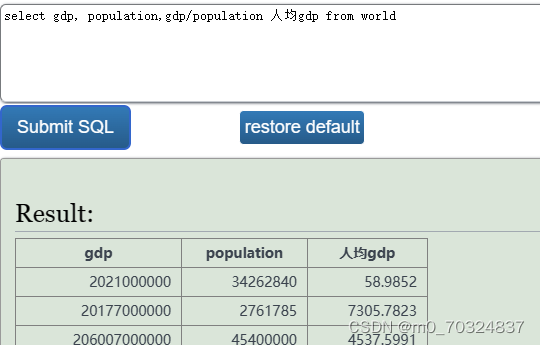
总结:1.基础语法:select字段名 from 表名
2.别名语法:select字段名as别名 from 表名
3.查询多列:select 字段1,字段2,字段3 from 表名
4.查询所有列:select* from 表名
5.数据去重:select distinct 字段名 from 表名
6.select中的计算字段:select 字段名,计算字段 from 表名
主要知识点二:where,筛选运算
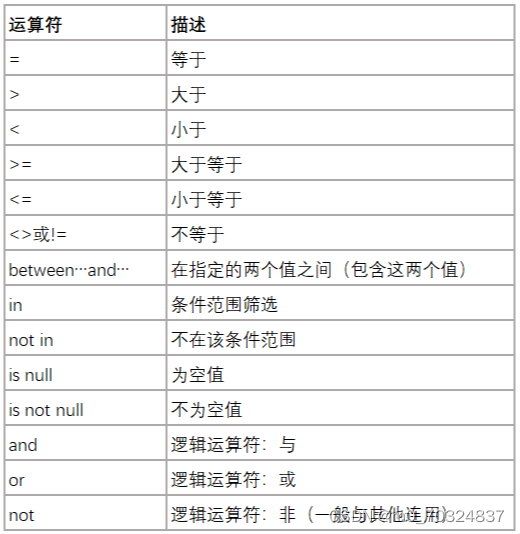
=、>、<、>=、<=、<>、!=为比较运算符,用于判断表中的哪些数据符合条件
and、or和not为逻辑运算符
and :一般用于组合两个及以上表达式,要求同时满足多个查询条件
or:一般用于组合两个及以上表达式,要求满足多个查询条件中的一个
not:not一般和与其他连用例如not in,用于条件取反
and和not可以一起使用,但是默认and优先级高于or,可以使用括号来界定优先级
between and,用于查询两个值之间范围的值(包含这两个值)
in,用于查询指定条件范围内的数据,一般为in (xxx,xxx,......),用括号将条件括起来,is null,用于查询空值(NULL),空值不同于0,也不同于null字符串
第一题:查询人口数至少2亿的国家名和人均gdp
Select name, gdp/population 人均gdp from world where population >=200000000
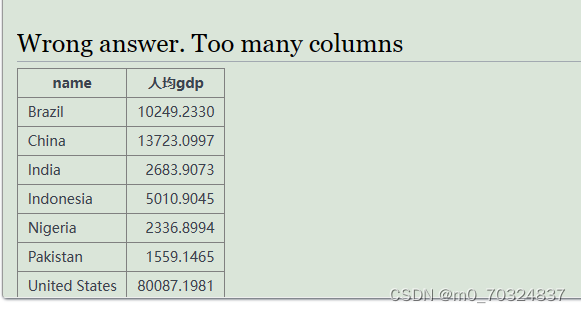
第二题:查询德国(Germany)的人口
Select name, population from world where name='Germany'

第三题:查询瑞典(Sweden)、挪威 (Norway) 和丹麦 (Denmark)的国家名和人口
Select name, population from world where name in ('Sweden','Norway','Denmark')

第四题:查询面积(area)在250000和300000之间的国家名和面积
Select name, area from world where area between 250000 and 300000(>250000 and area<300000也可)
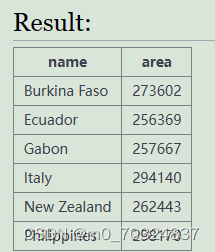
【模糊查询like】:where子句的表达式中除了使用运算符来进行条件判断,还可以使用like操作符组,通配符用来匹配值的一部分,跟在like后面进行数据过滤常用的通配符有%和_,%用来匹配多个字符可以是零个、一个也可以是多个字符,_仅能用来匹配单个字符

第五题:查询国家名中以C开头ia结尾的国家
select name from world where name like 'C%ia'
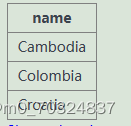
第六题:查询国家名中含有两个o且被两个字符隔开的国家名
Select name from world where name like '%o__o%'
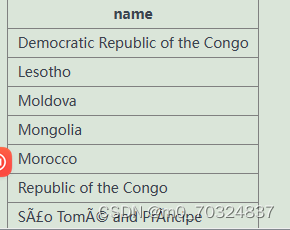
【多条件查询】:使用and或者or逻辑运算符对多个条件进行组合筛选想要的数据
第七题:查询国家名中含有三个a且面积大于60万(600000)的国家及其面积
Select name,area from world where name like '%a%a%a%' and area>=600000

第八题:查询国家名中含有三个a且面积大于60万(600000)的国家及其面积,或者人口大于13亿(1300000000)且面积大于500万(5000000)的国家及其面积
Select name, area from world where name like '%a%a%a%' and area >= 600000 or population >= 1300000000 and area >= 5000000
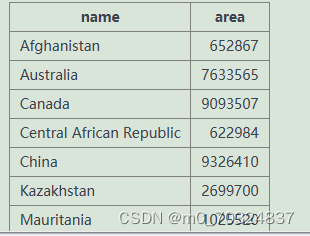
第九题:查询既包含有所有元音字母(a,e,i,o,u),同时国家名中没有空格的国家,最后显示他们的名字
Select name from world where name like '%a%' and name like '%e%' and name like '%i%' and name like '%o%' and name like '%u%' and name not like '% %'

第十题:查询1910年以前(不含1910)诺贝尔医学奖获得者和2004年及以后诺贝尔文学奖获得者的所有信息
Select * from noble where (subjiect in (‘Medicine’) and yr < 1910) and (subjiect in (‘Literature’) and yr >= 2004)
Select * from nobel where (subject = 'Medicine' and yr < 1910) or (subject = 'Literature' and yr >= 2004)
总结:1.标准语法:select字段名 from 表名 where表达式
2.运算符查询语法:select字段名 from 表名 where 字段名 运算符
3.模糊查询语法:select字段名 from 表名 where 字段名 like ‘通配符+字符’
4.使用多条件查询:select字段名 from 表名 where 条件代码1 and /or 2
主要知识点三:order by
order by 字段名 asc|desc 规定查询出的结果集显示的顺序order by核心子句是可选项,使用该子句是为了对被查询出的结果集,指定依据字段排序asc指定该字段升序排序,desc为降序排序,不写则默认为升序排序
第一题:查询姓名以Sir开头的获奖者(winner),获奖年份(yr)和科目(subject),查询结果按照年份从近到远排序,再按照姓名顺序升序排序
Select winner, yr, subject from nobel where winner like 'Sir%'
order by yr desc, winner asc

总结:1.标准语法:select字段名 from 表名 where 表达式 order by 字段名 asc /desc
第二题:查询1984年所有获奖者的姓名和奖项科目。结果将诺贝尔化学奖和物理学奖排在最后,然后按照科目排序,再按照获奖者姓名排序
Select winner, subject from nobel where yr = 1984 order by subject in (‘chemistry','physics’) , subject , winner(括号里为零自动降序排列)
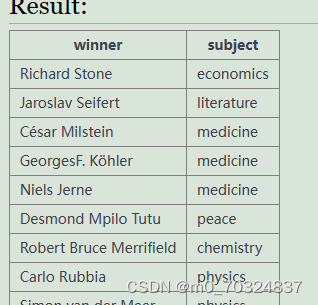
主知识点四:limit
limit [位置偏移量,]行数 限制查询结果集显示的行数limit子句是可选项,行数是子句中的必选参数,参数位置偏移量是可选参数
第一题:查询面积排名前三的国家
Select * from world order by area desc limit 3

第二题:查询人口数第4到第7的国家和人口
Select * from world order by area desc limit 3, 4(limit x, n 从x+1行开始记录n行,这道题就是从第四行开始记录4行)

第三题:查询nobel表中第100行到120行的数据
Select * from world order by area desc limit 99, 20

总结:1.查询结果返回前n行select 字段名from 表名 where 表达式order by 字段名 asc|desc limit n
- 查询结果从第x+1行开始记录n行select 字段名from 表名where 表达式 order by 字段名 asc|desc limit x,n
主知识点五:聚合函数&group by
group by 字段名 规定依据哪个字段分组聚合
group by核心子句是可选项,使用该子句是为了依据相同字段值分组后进行聚合运算,常和聚合函数联用
第一题:查询非洲总人口数
Select sum(population) 人口总数 from world where continent = 'africa'

将sum函数依次修改为avg()、max()、min(),依次计算平均人口数、最大人口数、最小人口数
Select avg(population),max(population),min(population) from world where continent = 'africa'

第二题:计算表格行数
Select count(*)from world

第三题:查询每个大洲(continent)和大洲内的国家(name)数量
Select continent,count(name) from world group by continent
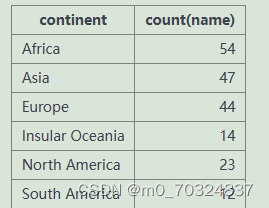
第四题:查询2013至2015年每年每个科目的获奖人数,结果按年份从大到小,人数从大到小排序
Select yr, subject,count(winner) 获奖人数 from nobel where yr between 2013 and 2015 group by yr subject order by yr, count(winner) desc
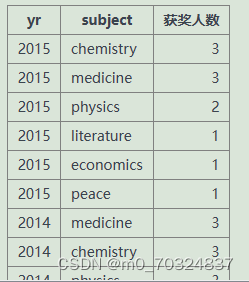
第五题:计算Estonia, Latvia, Lithuania这几个国家的总人口数
Select sum(population) 总人数 from world where name in ( 'Estonia', 'Latvia', 'Lithuania')

第六题:查询每个大洲和该大洲里人口数超过1千万的国家的数量
Select continent,count(name) from world where population > 10000000 group by continent

总结:聚合函数

标准语法:select 字段名1,聚合函数(字段名) from 表名where 表达式group by 字段名1 order by 字段名 asc|desc limit [位置偏移量,]行数
主知识点六:having&简单运行原理
having 表达式 限定分组聚合后的查询行必须满足的条件
having核心子句是可选项,使用该子句是为了对group by分组后的数据进行筛选
select 字段名from 表名where 表达式group by 字段名having 表达式order by 字段名 asc|desc limit [位置偏移量,]行数]
第一题:查询总人口数量至少为1亿(100000000)的大洲
Select continent from world group by continent having sum(population) >=100000000
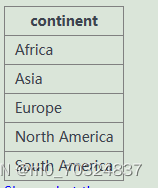
第二题:查询总人口数至少为3亿的大洲和其平均gdp,其中只有gdp高于200亿且人口数大于6000万或者gdp低于80亿且首都中含有三个a的国家的计入计算,最后按国家数从大到小排序,只显示第一行
Select continent, avg(gdp) 平均gdp from world where (gdp > 20000000000 and population > 60000000) or (gdp < 8000000000 and capital like '%a%a%a%') group by continent having sum(population) >= 300000000 order by count(name) desc limit 1

第三题:查询人均gdp大于3000的大洲及其人口数,仅gdp在200亿和300亿之间的国家计入计算
Select continent, sum(population)人口数, sum(gdp)/sum(population) 人均gdp from world where gdp > 20000000000 and gdp < 30000000000 group by continent having sum(gdp)/sum(population) > 3000

总结:select 字段名 from表名 where 表达式(分组前筛选) group by 字段名 having 表达式(分组后筛选) order by字段名asc desc limit 保留行数
主知识点七:部分常见函数
【数学函数】
round(x,y)——四舍五入函数
round函数对x值进行四舍五入,精确到小数点后y位
y为负值时,保留小数点左边相应的位数为0,不进行四舍五入
例如:round(3.15,1)返回3.2,round(14.15,-1)返回10
【字符串函数】
concat(s1,s2,...)——连接字符串函数
concat函数返回连接参数s1、s2等产生的字符串
任一参数为null时,则返回null
例如:concat('My',' ','SQL')返回My SQL,concat('My',null,'SQL')返回null
replace(s,s1,s2)——替换函数
replace函数使用字符串s2代替s中所有的s1
例如:replace('MySQLMySQL','SQL','sql')返回MysqlMysql
left(s,n)、right(s,n)&substring(s,n,len)——截取字符串一部分的函数
left函数返回字符串s最左边n个字符
right函数返回字符串s最右边n个字符
substring函数返回字符串s从第n个字符起取长度为len的子字符串,n也可以为负值,则从倒数第n个字符起取长度为len的子字符串,没有len值则取从第n个字符起到最后一位
例如:left('abcdefg',3)返回abc,right('abcdefg',3)返回efg,substring('abcdefg',2,3)返回bcd,substring('abcdefg',-2,3)返回fg,substring('abcdefg',2)返回bcdefg
【数据类型转换函数】
cast(x as type)——转换数据类型的函数
cast函数将一个类型的x值转换为另一个类型的值
type参数可以填写char(n)、date、time、datetime、decimal等转换为对应的数据类型
【日期时间函数】
year(date)、month(date)&day(date)——获取年月日的函数
date可以是年月日组成的日期,也可以是年月日时分秒组成的日期时间
year(date)返回日期格式中的年份
month(date)返回日期格式中的月份
day(date)返回年日期格式中的日份
例如:year('2021-08-03')返回2021,month('2021-08-03')返回8,day('2021-08-03')返回3
示例一:case when和if函数试运行
select recovered 累计治愈人数, case when recovered = 1 then 'one' when recovered >1 then 'more' else '0' end from covid where recovered > 0
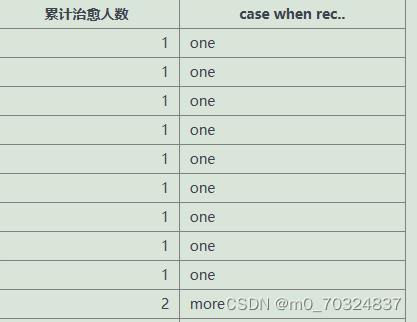
示例二:year、month、day函数试运行
select whn 更新时间, year(whn)年, month(whn)月, day(whn)日 from covid where recovered > 0

示例三:date_add函数试运行
select whn 时间, date_add(whn, interval 2 day)加2天from covid where recovered > 0

示例四:round和concat嵌套得到百分比数据
Select confirmed, deaths, recovered, recovered/confirmed, concat
(round((recovered/confirmed)*100,2),'%') 治愈率from covid where recovered/confirmed > 0.3

示例五:replace函数
Select distinct name, replace(name,'a','替换')替换 from covid
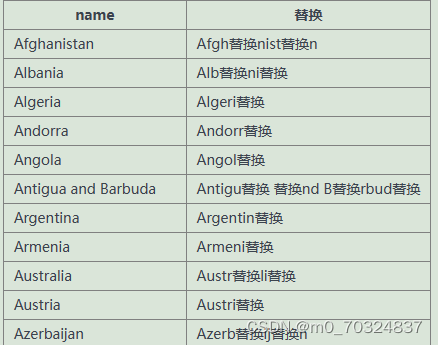
示例六:substring函数
Select distinct name, substring(name,2,3), substring(name,2) from covid where recovered/confirmed > 0.3

总结:【数学函数】
round(x,y)——四舍五入函数
【字符串函数】
concat(s1,s2,...)——连接字符串函数
replace(s,s1,s2)——替换函数
left(s,n)——从左截取字符串一部分的函数
right(s,n)——从右截取字符串一部分的函数
substring(s,n,len)——从指定位置截取字符串一部分的函数
【数据类型转换函数】
cast(x as type)——转换数据类型的函数
【日期时间函数】
year(date)——获取年的函数
month(date)——获取月的函数
day(date)——获取日的函数
date_add(date,interval expr type)——对指定起始时间进行加操作
date_sub(date,interval expr type)——对指定起始时间进行减操作
datediff(date1,date2)——计算两个日期之间间隔的天数
date_format(date,format)——将日期和时间格式化
【条件判断函数】——根据满足不同条件,执行相应流程
if(expr,v1,v2)
case when
case expr when v1 then r1 [when v2 then r2] ...[else rn] end
case when v1 then r1 [when v2 then r2]...[else rn] end
第一题:查询国家名称及其首都名称都以相同的字母开头的国家名及其首都,且不能包括国家名称和首都名称完全相同的情况
Select name, capital from world where left(name,1) = left(capital,1) and name != capital

第二题:查询首都和名称,其中首都需是国家名称的扩展例如:答案中应该包括墨西哥城(Mexico City),因为它比墨西哥(Mexico)更长,而不应该将卢森堡(Luxembourg)包括在内,因为首都名与国家名相同
Select name, capital from world where capital like concat('%',name,'%') and name != capital





















 177
177











 被折叠的 条评论
为什么被折叠?
被折叠的 条评论
为什么被折叠?








